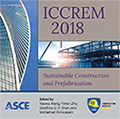International Conference on Construction and Real Estate Management 2018
A Study on the Stakeholder Influences during Green Building Operation in China
Publication: ICCREM 2018: Sustainable Construction and Prefabrication
ABSTRACT
Sustainable development has gradually become an overarching policy goal of various countries/regions and China is no exception. The architectural, engineering, and construction (AEC) industry consumes a large amount of resources and therefore plays a vital role realizing the spirit of sustainability in the country. Though green building industry has boomed during the last decade in China, barriers still exist hindering its further development such as emphasizing of sustainable design while ignoring sustainable operation. A participatory approach evaluating project performance during the operation phase is therefore suggested and a quantitative method prioritizing stakeholder impacts proposed to improve the effectiveness and efficiency of the overall process. The results indicate government organizations occupy the top of the list, followed by the owners and property management companies. The end-users as well as non-governmental organizations however stay at the bottom. Different strategies should be applied to achieve a rational distribution of participants from various stakeholder groups when evaluating sustainability during project operation.
Get full access to this article
View all available purchase options and get full access to this chapter.
ACKNOWLEDGMENTS
This work was supported by National Natural Science Foundation of China (Grant No. 71501074) and the State Key Lab of Subtropical Building Science, South China University of Technology, China (Grant No. 2016ZB16).
REFERENCES
Abidin, N.Z. (2010). “Investigating the awareness and application of sustainable construction concept by Malaysian developers.” Habitat International, 34(4), 421–426.
Amoatey, C. and Hayibor, M.V.K. (2017). “Critical success factors for local government project stakeholder management.” Built Environment Project and Asset Management, 7(2), 143–156.
André, P., Enserink, B., Connor, D. and Croal, P. (2006). Public Participation International Best Practice Principles, International Association for Impact Assessment, Fargo.
Atkin, B. and Skitmore, M. (2008). “Editorial: stakeholder management in construction.” Construction Management and Economics, 26(6), 549–552.
Bourne, L. and Walker, D.H.T. (2005). “Visualising and mapping stakeholder influence.” Management Decision, 43(5), 649–660.
Bourne, L. and Walker, D.H.T. (2008). “Project relationship management and the stakeholder circle.” International Journal of Managing Projects in Business, 1(1), 125–130.
Clarkson, M.B.E. (1995). “A stakeholder framework for analyzing and evaluating corporate social performance.” Academy of Management Review, 20(1), 92–117.
Enserink, B. and Koppenjan, J. (2007). “Public participation in China: sustainable urbanization and governance.” Management of Environmental Quality: An International Journal, 18(4), 459–474.
Freeman, R.E. (1984). Strategic management: A stakeholder approach, Pitman, Boston.
Johnson, G. and Scholes, K. (1999). Exploring corporate strategy, Prentice Hall Europe, London.
Li, H., Ng, S.T. and Dong, Y. (2018). “Stakeholder analysis of sustainable construction in China.” Proceedings of 21st International Conference on “Advancement of Construction Management and Real Estate”, Hong Kong, China, 14–17.
Li, H., Zhang, X., Ng, S. T. and Skitmore, M. (2017). “Quantifying stakeholder influence in decision/evaluations relating to sustainable construction in China–a Delphi approach.” Journal of Cleaner Production, (2018), 77–89.
Li, T.H.Y., Ng, S.T. and Skitmore, M. (2012a). “Public participation in infrastructure and construction projects in China: from an EIA-based to a whole-cycle process.” Habitat International, 36(1), 47–56.
Li, T.H.Y., Ng, S.T. and Skitmore, M. (2012b). “Conflict or consensus: an investigation of stakeholder concerns during the participation process of major infrastructure and construction projects in Hong Kong.” Habitat International, 36(2), 333–342.
Ministry of Housing and Urban-Rural Development of China. (2014). Methods and Practices of Post-Occupancy Evaluation of Green Buildings in China, Construction Science and Technology, Beijing. (in Chinese).
Mitchell, R.K., Agle, B.R. and Wood, D.J. (1997). “Toward a theory of stakeholder identification and salience: defining the principle of who and what really counts.” Academy of Management Review, 22(4), 853–886.
Ng, S.T., Li, T.H.Y. and Wong, J.M.W. (2012). “Rethinking public participation in infrastructure projects.” Proceedings of the Institution of Civil Engineers: Municipal Engineer, 165(2), 101–113.
OECD (2009). Focus on Citizens: Public Engagement for better Policy and Services, Organization for Economic Co-operation and Development, Paris.
Ogunbiyi, O., Goulding, J.S. and Oladapo, A. (2014). “An empirical study of the impact of lean construction techniques on sustainable construction in the UK.” Construction Innovation, 14(1), 88–107.
PMI (2008). A guide to the project management body of knowledge (4thedition), Project Management Institute, Pennsylvania.
Robichaud, L.B. and Anantatmula, V.S. (2010). “Greening project management practices for sustainable construction.” Journal of Management in Engineering, 27(1), 48–57.
Stefan, Olander. (2007). “Stakeholder impact analysis in construction project management.” Construction Management and Economics, 25(3), 277–287.
Wang, L., Zhou, X.H. and Wang, Y.Q. (2012). “A review on the research of project stakeholder impact evaluation.” Project Management Technology, 10(9), 56–60.
Information & Authors
Information
Published In
ICCREM 2018: Sustainable Construction and Prefabrication
Pages: 114 - 120
Editors: Yaowu Wang, Professor, Harbin Institute of Technology, Yimin Zhu, Professor, Louisiana State University, Geoffrey Q. P. Shen, Professor, Hong Kong Polytechnic University, and Mohamed Al-Hussein, Professor, University of Alberta
ISBN (Online): 978-0-7844-8173-8
Copyright
© 2018 American Society of Civil Engineers.
History
Published online: Aug 8, 2018
Authors
Metrics & Citations
Metrics
Citations
Download citation
If you have the appropriate software installed, you can download article citation data to the citation manager of your choice. Simply select your manager software from the list below and click Download.
